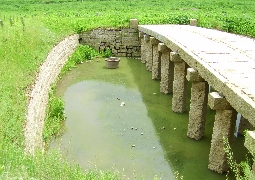
Transportation by road that went to Seoul, Gangmae-dong Seokgyo
At the end of the East side of Haengsin District, which is now developed as a new city, there is Gyeongui Line Gangmae Station. There is a road going to Mt. Bongdaesan in the southern part of Gangmae Station. On this bank you can see the bridge about 50m along the dirt road in the direction opposite to the platform acid. This is Gangmae-dong bridge. Gangmae-dong is a bridge that was used as a traffic passage for Western people on the Han River coast, including Ilsan, Jido, and Songpo of old Goyang. The basic structure of the bridge consists of 18 square pylons with built up piers and a rectangular bridge over them. There are 6 to 7 columns and the piers are in 2 columns. The overall shape of the bridge extends from south to north, with the middle part of the bridge being higher than both sides, forming an overall curve. According to the “Goyanggunji” published in the year of King Yeongjo in 1755, it was named Haepogyo and made of wood. The record as a stone bridge can be seen in the 1920s of ‘Gangmerigyo Bridge Gyeongsinsinjo‘ engraved on the bridge railing. Gangmae-dong Seokgyo can be accessed from Gangmae Station or from Soman Village of Haengsin-dong. It is known to be the only traditional gyoryangbi In Goyang City as a cultural asset of Joseon Dynasty is well preserved.
Bridge
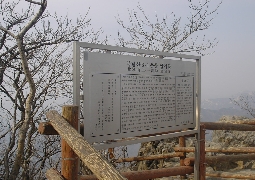
Bukhansan 3.1 March First Independence Movement Amgakmun Gate
3.1 Independence Movement Amgakmun Gate is craved on the granite stone of Baekunbong, the main peak of Mt.
Bukhansan. The written script is, firstly the 4 letters of ’Gyeongcheonaein’ on a flat rock, sized 150cm horizontally and 270cm vertically, and inside it said “The Independence Declaration was written by Choi Namsun on Giminyeon Feb 10, and on 1 March I have proudly declared Independence at Topdong Park.” It is not known exactly when and when the text was written, but it is estimated to be after the 3.1 Movement, and the purpose seems to be to permanently convey the historical facts of the gigantic independence movement. Jeong Jaeyong, who craved the text, was an independence activist, born in 1886 in Haeju. After starting the 3.1 Movement, he returned to Haeju and continued to fight for independence until he was arrested by Japanese in 1920 and imprisoned in Pyeongyang prison for 2 and a half years. He died at the age of 91 in 1976. The next year in 1977, he was awarded for the National Foundation Medal, and the same medal again and the National Foundation Recognition Medal in 1990.
Square stone
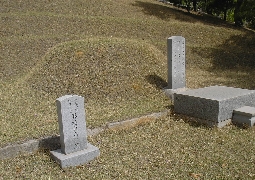
Ryu Gyeom teacher's grave
Designation number: Regional Cultural Properties No. 31
Location: Mt. 106-8, Haengsin-dong, Deokyang-gu, Goyang-si, Gyeonggi-do
Ryu Gyeom’s grave is located in Muwon Village, Haengsin-dong, and is merged with the grave of his wife Chungchu Cho. There is a stone statue in front of the grave of the Ryu Gyeom’s, and in particular, Mangjuseok is unique in its bottom part (Guibu) and Muninseok with the characteristics of mid and late Joseon Dynasty. The gravestone in front of the temple is 103cm in height, 36cm in width and 12cm in thickness. Muninseok stood out with delicate technique and realistic expression, and the proportional aspect of human body is remarkable. Ryu Gyeom was born in the 5th year of Goryeo Dynasty of King Gongmin (1357) and passed away in Joseon Taejong 11th (1411). In 6th year of Goryeo Wuwang (1380), he passed offer exams and in Joseon Taejong 10th (1410), he became a member of Seongjongno. Originally his grave was in Hwajeon, but was replaced in 1937 to the place now.
Minmyeong

Ryu Ku's grave with an unusual shape of Muninseok
Designation number: Regional Cultural Properties No. 30
Location: Mt. 106-8, Haengsin-dong, Deokyang-gu, Goyang-si, Gyeonggi-do
Ryu Ku’s grave is located in the cemetery of Jinju Ryu in Muwon Village of Haengsin-dong, merged with the grave of his wife Deoksoo Lee. Particularly, it is written ‘Daehaksa Ryu Ku’ with a simple method. Ryu Ku’s grave depicts of Goryeo Dynasty’s statue look, since it was built in very early stage of Joseon Dynasty. Some of the stone and other stonework show the style after the mid-Joseon Dynasty. Of these, stone lanterns show a unique feature, having two hands crossed at front. Ryu Ku was born in King Chungsu of Koryo 3rd (1335) and died in Joseon Dynasty 7th (1398). He was handed over to Jinsan County as a patriarch of Korea, and added to Seongjong University as Cheongbaekri. Currently, the most prevalent figure in the grave of Jinju and siho is Jeongpyeonggong.
Minmyeong
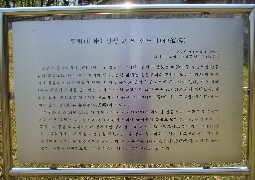
Ryu Rim's grave
The grave of Ryu Rim is located in Muwon Village, Haengsin-dong, and is merged with the grave of Andong Kim. At 100m below the grave, there is a Sindobi built in August of the Suksong 21st (1695). Sindobi is equipped with an Okgaeseok, the inscription is made by Namwon, written by son Jibal and told by Hongsuju. Ryu Rim returned to Injo 21st (1643) by the dignity of the mid-Joseon Dynasty. His son is Yeo-on, family chan of Jinju and he is grandson of Gongjopanseo Jindong. In Seonjo 36 (1603), he passed official exams, and in Injo 14th (1636), he defended the castle with a stronghold of Pyeongmajeoldosa, and succeeded in defeating the attack of Cheonggun. In Ganghwa Province, by striking the enemy coming from the South, he established a major success. He went through various positions until he was promoted to Woouijeong, and his siho was Chungjang.
Minmyeong
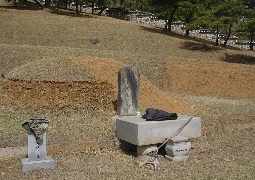
Ryu Jindong Teacher’s Tomb
The tomb of Ryu Jindong is located in the southern part of Jinju Ryu’s Cemetery Park in Haengsin-dong Muwon Village. The marble says that it is the Tomb of the Governor of the Ministry of Finance and Economy. According to the inscription, this statue was built in Myeongjong 17th (1562), and there is a monument house 50m below the tomb built in Myeongjong 18th (1563) where is made with Okgae stones. Ryu Jindong was a liege in the mid-Joseon Dynasty and was born in Yeonsangun 3rd (1497) until death in Myeongjong 16th (1561). He is the son of Hanpyeong. In Jungjong 17th (1522) he served Samasi, in 1531 passed the officer exams, Jungjong’s 33th (1538) served as Jeongun and more, and in Jungjong 38th (1543), to Bujehak officer. He served many more positions until Myeongjong 14th (1559) until his death by stroke. He was known to be excellent in writing and painting, and wrote the “Soongnyemun”.
Minmyeong
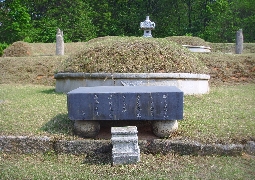
Kangji teacher's grave
The grave of Kangji is located on the right road from Hachon to Sangchon Village in Ogeum-dong, and it has a sindobi established in the spring of 1959, written ‘Kimyundongchanbyeongseo’. The rain that is built on the tomb is recorded as ‘Jeonggukgongsin Yeongseongun Gangjimyo Tomb’. The stones believed to be built in the present are Muninseok and Mangjuseok, and the Jangmyeong lights, which is supported by two lions, were established in the later years. Kangji was born in the first year of Danjong (1453) and passed away on June 30, 1217 (1517) at Jungjong’s 12th. Name is Dukyun, ho is Moam and a grandson of Jinju’s Hwoijung. He was graced by receiving a thank-you letter from the King as being wise and courageous.
Minmyeong
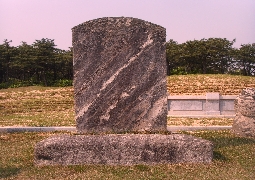
The one to set Danjong’s grave as Neung, Park Chungwon's grave
The stone statues was built in 1958, and the old stone sculptures built in February of the 9th year of Gwanghae (1617) were made of marble, with the scale 180cm high, 56cm wide and 27.2cm thick. The newly built Sintobi was built in 1795 of Jeongjo 19th, and has a head and a pedestal of gravestone, which is 297cm high, 117cm wide and 52cm thick. Park Chungwon (1507~1581) is a liege of mid-Joseon Dynasty, name is Jungcho, Ho is Nakchon, family of Milyang. One of Goyang 8 hyeon, and had served as Myeongwolgunsu, and officers of Chunchugwan and Seongcheon.
Minmyeong
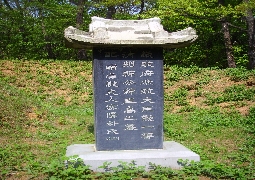
Loyal officer of the late Joseon Dynasty who protested against Japanese colony
Han Gyuseol is politician in late Joseon Dynasty and the younger brother of the general manager Chongyungsa Gyujik. He passed the officer exams and served from Hyeonjo to Pododaejang (a police chief). In 1905, he organized and participated in the Uijeongbu government. In November 9 of the same year, the Japan initialized army protests and forced for Eulsajoyak treaty (Japan-Korea Treaty of 1905), but he had insisted on the unfairness of the treaty. After the signing of the treaty, he was fired, returned to hometown and later served as Chief advisor. A baron was awarded by the Japanese government during the Japanese colonies, but he refused and returned in 1930. The tomb of Han Gyuseol is located in Wonheung-dong with Milyang Park. On the right side of the tomb is a stone statue of 190cm high, 50cm wide and 25cm thick and other guiding stones, and in October 1934, the height of the gravestone built by son Yangho was 146cm high, 50cm wide, and 20cm thick.
Minmyeong
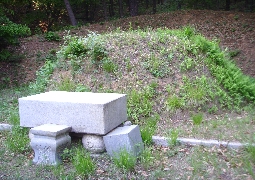
The First Prime Minister of the Ministry, The Tomb of Mr. HongJip Kim
The tomb of Mr. Kim Hong Jip has recently built Myogal, Sangsuk, Hyangrosuk, Jangmyung deung and a pair of Mangjusuk and is located in Daejagol in Daejadong with the tomb of the wife of Mr. Kim Hong Jip, Mrs. Hong of Namyang.
The total circumference of the burial mound is 15 meters at present, and the grave has been moved to the present place from Paju in June 11, 1975 with the Myogal standing on the right side of the burial mound.
The epitaph of tombstone, which has a Roof of Stone Stupa, was written and erected a descendant named Jungrok. Kim Hong Jip(1842~1896) was a politician of the late Joseon Dynasty and the other name was Gueng-jip, his adult name was Gyeung-nung, his name called comfortably was Dowon, and the place where he lived was Kyungju.
Kim Hong Jip passed the civil service examination in the 5th year of King Gojong's reign and went on an official trip to Japan as the minister of culture and education after becoming a diplomatic delegation in 1880. He introduced 'The diplomatic policies of Joseon' written by Hwang Jun Hun who was chinese and got a promotion for making a contribution in carrying on the policy of advancement. However, he resigned when confucianists started an expulsion agitation all over the country who opposed to the advancement.
In the 19th year of King Gojong's reign(the year 1882), he was once again appointed when complicated international problems such as the commercial requests of the great powers of Europe and America and putting things to rights after the Im-O Military Revolt pressed the government. He demonstrated diplomacy skills and was promoted as the governor of Kyeonggi province.
He resigned in 1884 when the Gapsin Coup occured. He signed the Japan-Korea Treaty of 1885 after being a diplomatic delegation through the second vice-premier and the first vice-premier.
Minmyeong
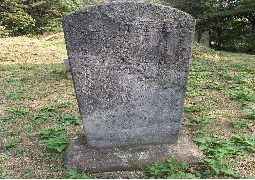
The tomb of Mr. Ki-Eung Se
The tomb of Mr. Ki-Eung Se is located in the Sageunjul village in Sungsa-dong. There is a twin grave which is the grave of Mrs. Lim of Sunsan.
The marble tombstone(height 120 centimeters, width 40 centimeters, thickness 18 centimeters) right in front of the burial mound was placed in the 19th year of the King Sunjo's reign(in the year 1586) and the roof of stone stupa of the Jangmyeongdeung is left laying down in front of the tombstone.
There are two tombstones and a Sangsuk, Hyangrosuk and a Mangjuseok, and a pair of Muninsuk in the right and left side of the tombstone in front. The Muninseok in the right side and left side is regarded as a valuable thing because of its unusual facial expression and because it was relatively made in detail.
Also one can see the handwritings of the master calligrapher, Hanseokbong, and Jujibeon of Ming Dynasty.
Mr. Ki-Eung Se(1539-1585) is the government official of the mid Joseon era and is a devoted son and the adult name is Kyeong Oo, and the grandson of Bokjae Kijun who is from Goyangpalhyun, and is the son of Ki Dae Hang who was in the public office(Han Sung Pan Yoon), and the father of Ki-Ja Hun who was the prime minister of the Joseon Dynasty and is from Haengju.
He had a filial behavior in the usual days so he received a monument from King Seonjo of the Joseon Dynasty and was rewarded and written in the Samgangrok.
Minmyeong
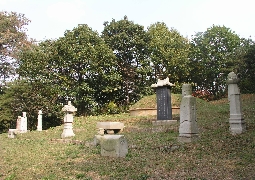
The end of Goryeo, Cheongbaekri in the early years of Joseon, the tomb of Mr. Gi-gun
The tomb of Mr. Gi-gun is located in the west direction of Sageunjeol village in Sungsadong which is in the direction of the Hanyang country club near the Wondang subway station.
He is buried together with his wife Mrs. Hong from Pungsan. The tomb is shaped in a circle form and the whole scale of the circumference is 21 meters.
There is a tombstone which O-uk ryung newly built and praised in 1966 in the right side of the burial mound and there is also the Korean-writing-written tombstone which the descendant Ki sung do built and praised recently.
Shindo tombstone which is located about 300 meters beneath the grave was built in October of the 16th year of King Gojong (1879). It has a Paljak roof formed roof of stone stupa and a rectangle tongdaesuk brace and the Bishin(body part of the tombstone) is made of marble.
The Shindo tombstone Goobi is laid in the front yard of the Shinbi.
Mr. Gigun was the government official of the early Joseon Dynasty and was the son of Myun who was the minister of Gongjo, He was born in 1390 and died in 1460.
The name called comfortably was Chungpa or Hyunam and the Nok was Chungbaekri and the place where he lived was Haengju.
He had an upright nature, and he liked reading and studying.
In the 24th year of King Sejong(1442) he was selected when he was a commoner and became a Jipyeong in the public office through the Eumsa system and went through Byungjo, Hyungjo, Ijo in the public office and was the governor(Gwanchalsa, Daesahun) and went through the governor of the special administrative regions in the first year of King Munjong(1451) and became Daesahun(governor) in the first year of King Danjong(1453).
He was famous for being the Chungbaekri while he was the governor(Gwanchalsa) in Yeonan, Jeju, and Pyeongando public office
Afterwards he worked in the government post but resigned from all public offices when Sejo became King.
King Sejo found his house several times but he didn't come back. His name afterwards when he died(Siho) was called Jungmu.
Minmyeong











